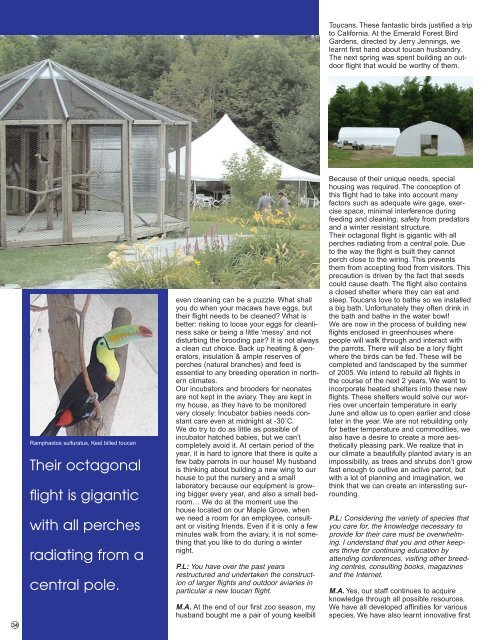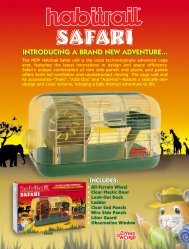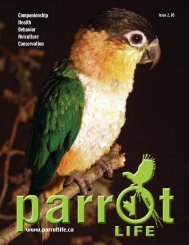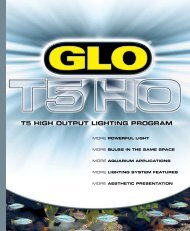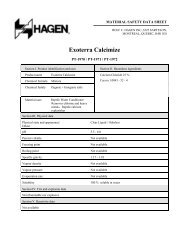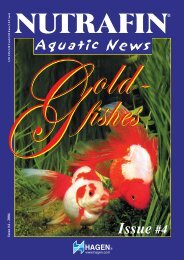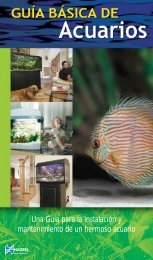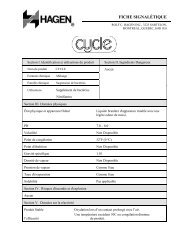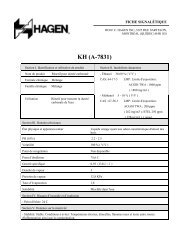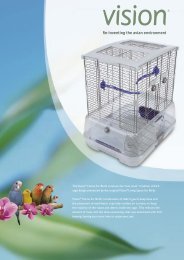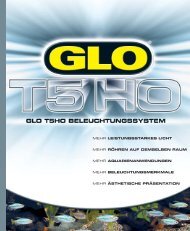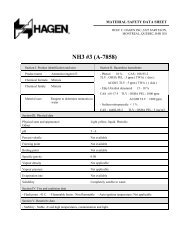parrotLife_Printers-3 (Page 1) - Rolf C. Hagen Inc.
parrotLife_Printers-3 (Page 1) - Rolf C. Hagen Inc.
parrotLife_Printers-3 (Page 1) - Rolf C. Hagen Inc.
You also want an ePaper? Increase the reach of your titles
YUMPU automatically turns print PDFs into web optimized ePapers that Google loves.
34<br />
Ramphastos sulfuratus, Keel billed toucan<br />
Their octagonal<br />
flight is gigantic<br />
with all perches<br />
radiating from a<br />
central pole.<br />
even cleaning can be a puzzle. What shall<br />
you do when your macaws have eggs, but<br />
their flight needs to be cleaned? What is<br />
better: risking to loose your eggs for cleanliness<br />
sake or being a little ‘messy’ and not<br />
disturbing the brooding pair? It is not always<br />
a clean cut choice. Back up heating & generators,<br />
insulation & ample reserves of<br />
perches (natural branches) and feed is<br />
essential to any breeding operation in northern<br />
climates.<br />
Our incubators and brooders for neonates<br />
are not kept in the aviary. They are kept in<br />
my house, as they have to be monitored<br />
very closely: <strong>Inc</strong>ubator babies needs constant<br />
care even at midnight at -30˚C.<br />
We do try to do as little as possible of<br />
incubator hatched babies, but we can’t<br />
completely avoid it. At certain period of the<br />
year, it is hard to ignore that there is quite a<br />
few baby parrots in our house! My husband<br />
is thinking about building a new wing to our<br />
house to put the nursery and a small<br />
laboratory because our equipment is growing<br />
bigger every year, and also a small bedroom…<br />
We do at the moment use the<br />
house located on our Maple Grove, when<br />
we need a room for an employee, consultant<br />
or visiting friends. Even if it is only a few<br />
minutes walk from the aviary, it is not something<br />
that you like to do during a winter<br />
night.<br />
P.L: You have over the past years<br />
restructured and undertaken the construction<br />
of larger flights and outdoor aviaries in<br />
particular a new toucan flight.<br />
M.A. At the end of our first zoo season, my<br />
husband bought me a pair of young keelbill<br />
Toucans. These fantastic birds justified a trip<br />
to California. At the Emerald Forest Bird<br />
Gardens, directed by Jerry Jennings, we<br />
learnt first hand about toucan husbandry.<br />
The next spring was spent building an outdoor<br />
flight that would be worthy of them.<br />
Because of their unique needs, special<br />
housing was required. The conception of<br />
this flight had to take into account many<br />
factors such as adequate wire gage, exercise<br />
space, minimal interference during<br />
feeding and cleaning, safety from predators<br />
and a winter resistant structure.<br />
Their octagonal flight is gigantic with all<br />
perches radiating from a central pole. Due<br />
to the way the flight is built they cannot<br />
perch close to the wiring. This prevents<br />
them from accepting food from visitors. This<br />
precaution is driven by the fact that seeds<br />
could cause death. The flight also contains<br />
a closed shelter where they can eat and<br />
sleep. Toucans love to bathe so we installed<br />
a big bath. Unfortunately they often drink in<br />
the bath and bathe in the water bowl!<br />
We are now in the process of building new<br />
flights enclosed in greenhouses where<br />
people will walk through and interact with<br />
the parrots. There will also be a lory flight<br />
where the birds can be fed. These will be<br />
completed and landscaped by the summer<br />
of 2005. We intend to rebuild all flights in<br />
the course of the next 2 years. We want to<br />
incorporate heated shelters into these new<br />
flights. These shelters would solve our worries<br />
over uncertain temperature in early<br />
June and allow us to open earlier and close<br />
later in the year. We are not rebuilding only<br />
for better temperature and commodities, we<br />
also have a desire to create a more aesthetically<br />
pleasing park. We realize that in<br />
our climate a beautifully planted aviary is an<br />
impossibility, as trees and shrubs don’t grow<br />
fast enough to outlive an active parrot, but<br />
with a lot of planning and imagination, we<br />
think that we can create an interesting surrounding.<br />
P.L: Considering the variety of species that<br />
you care for, the knowledge necessary to<br />
provide for their care must be overwhelming.<br />
I understand that you and other keepers<br />
thrive for continuing education by<br />
attending conferences, visiting other breeding<br />
centres, consulting books, magazines<br />
and the Internet.<br />
M.A. Yes, our staff continues to acquire<br />
knowledge through all possible resources.<br />
We have all developed affinities for various<br />
species. We have also learnt innovative first


